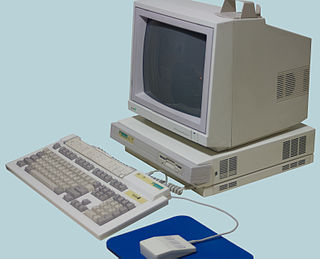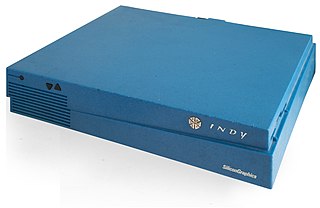
The history of the graphical user interface, understood as the use of graphic icons and a pointing device to control a computer, covers a five-decade span of incremental refinements, built on some constant core principles. Several vendors have created their own windowing systems based on independent code, but with basic elements in common that define the WIMP "window, icon, menu and pointing device" paradigm.

Acorn Archimedes is a family of personal computers designed by Acorn Computers of Cambridge, England. The systems are based on Acorn's own ARM architecture processors and the proprietary operating systems Arthur and RISC OS. The first models were introduced in 1987, and systems in the Archimedes family were sold until the mid-1990s.
In computer graphics, planar is the method of arranging pixel data into several bitplanes of RAM. Each bit in a bitplane is related to one pixel on the screen. Unlike packed, high color, or true color graphics, the whole dataset for an individual pixel isn't in one specific location in RAM, but spread across the bitplanes that make up the display. Planar arrangement determines how pixel data is laid out in memory, not how the data for a pixel is interpreted; pixel data in a planar arrangement could encode either indexed or direct color.
The Atari Transputer Workstation is a workstation class computer released by Atari Corporation in the late 1980s, based on the INMOS transputer. It was introduced in 1987 as the Abaq, but the name was changed before sales began. Sales were almost non-existent, and the product was canceled after only a few hundred units had been produced.

A framebuffer is a portion of random-access memory (RAM) containing a bitmap that drives a video display. It is a memory buffer containing data representing all the pixels in a complete video frame. Modern video cards contain framebuffer circuitry in their cores. This circuitry converts an in-memory bitmap into a video signal that can be displayed on a computer monitor.

A random-access memory digital-to-analog converter (RAMDAC) is a combination of three fast digital-to-analog converters (DACs) with a small static random-access memory (SRAM) used in computer graphics display controllers or video cards to store the color palette and to generate the analog signals to drive a color monitor. The logical color number from the display memory is fed into the address inputs of the SRAM to select a palette entry to appear on the data output of the SRAM. This entry is composed of three separate values corresponding to the three components of the desired physical color. Each component value is fed to a separate DAC, whose analog output goes to the monitor, and ultimately to one of its three electron guns.

The DECstation was a brand of computers used by DEC, and refers to three distinct lines of computer systems—the first released in 1978 as a word processing system, and the latter two both released in 1989. These comprised a range of computer workstations based on the MIPS architecture and a range of PC compatibles. The MIPS-based workstations ran ULTRIX, a DEC-proprietary version of UNIX, and early releases of OSF/1.

The Indy, code-named "Guinness", is a low-end multimedia workstation introduced on July 12, 1993. Silicon Graphics Incorporated (SGI) developed, manufactured, and marketed Indy as the lowest end of its product line, for computer-aided design (CAD), desktop publishing, and multimedia markets. It competed with Intel x86 computers, and with Windows and Macintosh, including using their files and running their applications via software emulation. It is the first computer to come standard with a video camera, called IndyCam. Indy was repackaged as a server model called Challenge S. Indy was discontinued on June 30, 1997 and support ended on December 31, 2011.
Text mode is a computer display mode in which content is internally represented on a computer screen in terms of characters rather than individual pixels. Typically, the screen consists of a uniform rectangular grid of character cells, each of which contains one of the characters of a character set; at the same time, contrasted to all points addressable (APA) mode or other kinds of computer graphics modes.
Inmos International plc and two operating subsidiaries, Inmos Limited (UK) and Inmos Corporation (US), was a British semiconductor company founded by Iann Barron, Richard Petritz, and Paul Schroeder in July 1978. Inmos Limited’s head office and design office were at Aztec West business park in Bristol, England.

The O2 was an entry-level Unix workstation introduced in 1996 by Silicon Graphics, Inc. (SGI) to replace their earlier Indy series. Like the Indy, the O2 used a single MIPS microprocessor and was intended to be used mainly for multimedia. Its larger counterpart was the SGI Octane. The O2 was SGI's last attempt at a low-end workstation.
The MIPS Magnum was a line of computer workstations designed by MIPS Computer Systems, Inc. and based on the MIPS series of RISC microprocessors. The first Magnum was released in March, 1990, and production of various models continued until 1993 when SGI bought MIPS Technologies. SGI cancelled the MIPS Magnum line to promote their own workstations including the entry-level SGI Indy.

SGI Visual Workstation is a series of workstation computers that are designed and manufactured by SGI. Unlike its other product lines, which used the 64-bit MIPS RISC architecture, the line used Intel Pentium II and III processors and shipped with Windows NT 4.0 or Windows 2000 as its operating system in lieu of IRIX. However, the Visual Workstation 320 and 540 models deviated from the architecture of IBM-compatible PCs by using SGI's ARCS firmware instead of a traditional BIOS, internal components adapted from its MIPS-based products, and other proprietary components that made them incompatible with internal hardware designed for standard PCs and hence unable to run other versions of Microsoft Windows, especially Windows 9x. By contrast, the remaining models in the line are standard PCs, using VIA Technologies chipsets, Nvidia video cards, and standard components.

The Indigo, introduced as the IRIS Indigo, is a line of workstation computers developed and manufactured by Silicon Graphics, Inc. (SGI). SGI first announced the system in July 1991.
DeskStation Technology was a manufacturer of RISC-based computer workstations intended to run Windows NT. DeskStation was based in Lenexa, Kansas.

Dual-ported video RAM, or VRAM, is a dual-ported variant of dynamic RAM (DRAM), which was once commonly used to store the framebuffer in graphics adapters. Note that most computers and game consoles do not use this form of memory, and dual-ported VRAM should not be confused with other forms of video memory.

A video display controller or VDC is an integrated circuit which is the main component in a video-signal generator, a device responsible for the production of a TV video signal in a computing or game system. Some VDCs also generate an audio signal, but that is not their main function.
The AAA chipset was intended to be the next-generation Amiga multimedia system designed by Commodore International. Initially begun as a secret project, the first design discussions were started in 1988, and after many revisions and redesigns the first silicon versions were fabricated in 1992–1993. The project was stymied in 1993 based on a lack of funds for chip revisions.
IrisVision is an expansion card developed by Silicon Graphics for IBM compatible PCs in 1991 and is one of the first 3D accelerator cards available for the high end PC market. IrisVision is an adaptation of the graphics pipeline from the Personal IRIS workstation to the Micro Channel architecture and consumer ISA buses of most modern PCs of the day. It has the first variant of IRIS GL ported to the PC, predating OpenGL.
Amiga Ranger is an unreleased prototype personal computer by Commodore which was intended to be the second generation Amiga chipset, prior to ECS. It was designed by the original Los Gatos Amiga team including Jay Miner.








